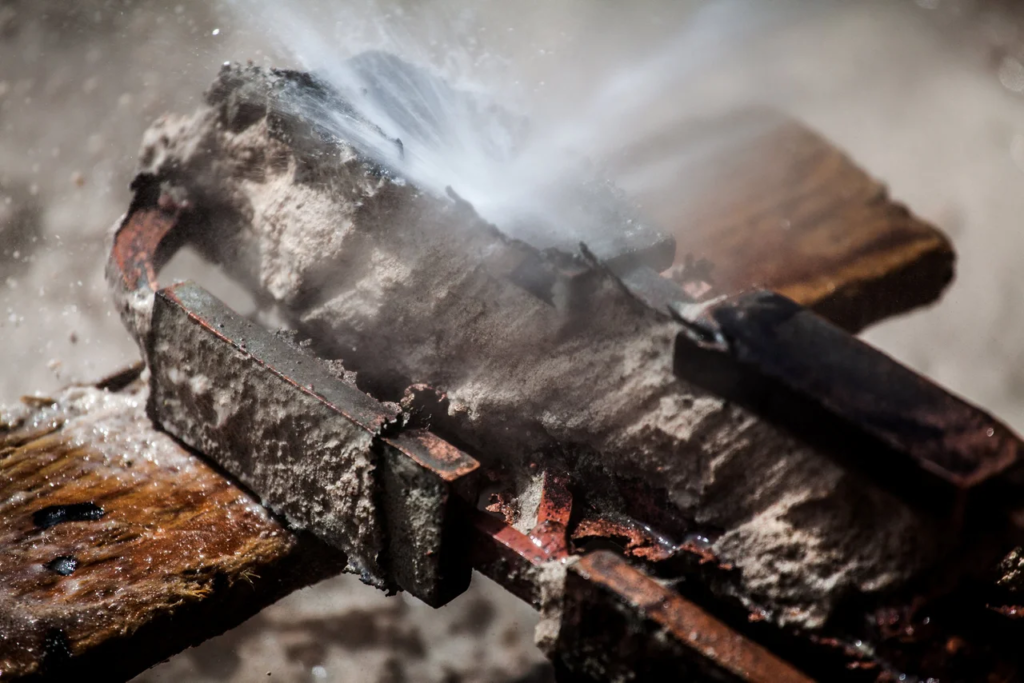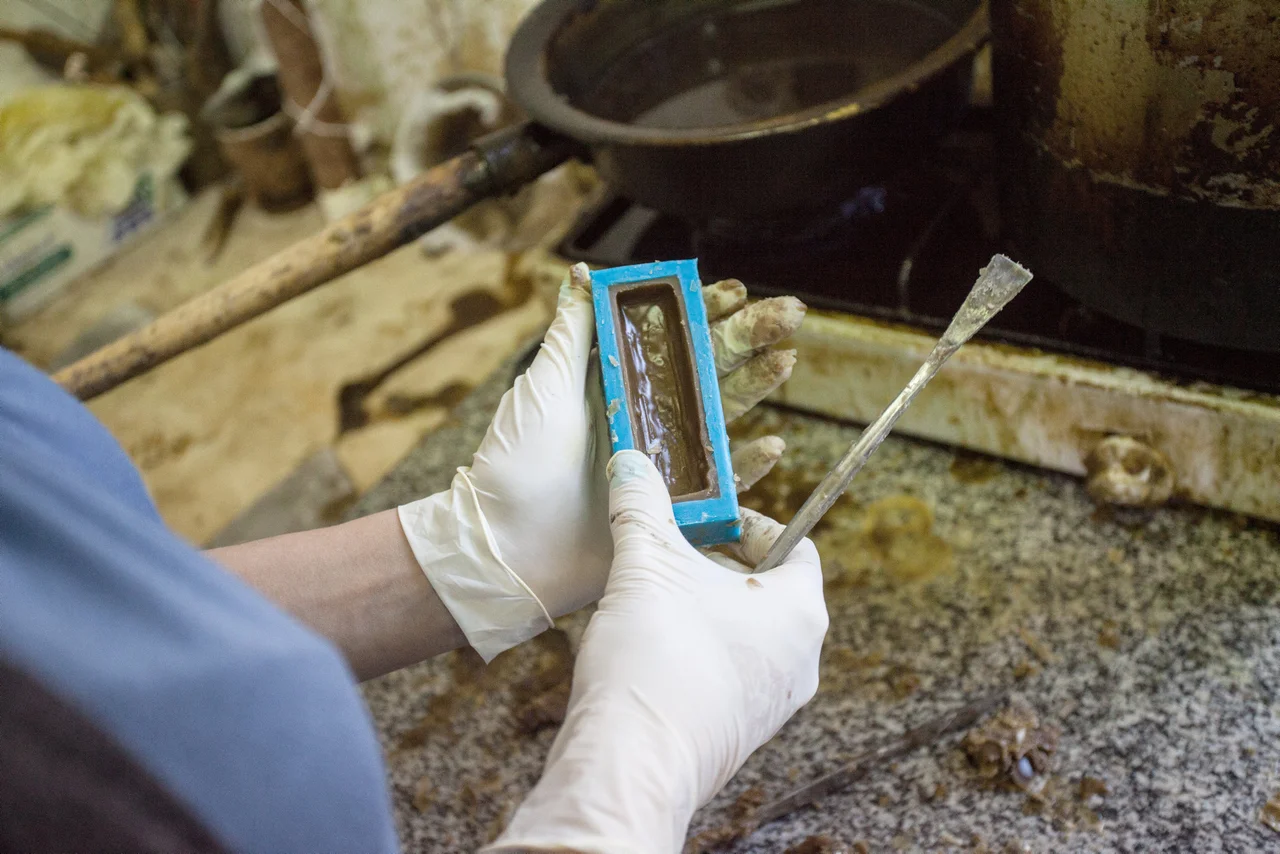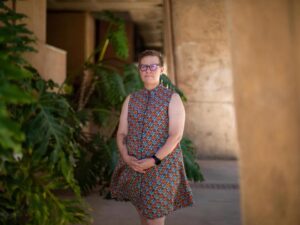Helena Czernek and Aleksander Prugar cast old Mezuzah traces left behind across Poland and recreate them: ‘Synagogues are traces of communities, mezuzahs are traces of those who were murdered’
The abandoned house on 14 Próna Street in Warsaw is a pilgrimage site for tourists. The building is dilapidated, and entry is dangerous: The façade is crumbling, there are bricks missing and the interior has been looted and destroyed. And yet, it still has great charm. Given that it hasn’t been renovated in the 77 years since the end of World War II, it remains as an authentic remnant of a bygone Jewish world that no longer exists in Poland.
Helena Czernek, 37, and Aleksander Prugar, 38, formerly a couple and now colleagues, recently stepped through the building’s gates as part of a unique project that they have been engaged in for the past several years. On one of the doorposts, they found the last evidence of the building’s original tenants: The traces of the mezuzah that once affixed there – peeling and covered with patina.
Without hesitation, the two open the satchel containing the appropriate work equipment: A paste containing a special substance that molds to the surface on which it’s spread. They copy the imprints of the original mezuzah, which had been removed. Later, in their workshop, they use the imprint to produce a new bronze mezuzah. “It’s not a replica, because we don’t have the original, it’s a new mezuzah based on the traces left behind by the original,” says Czernek.
On their website, which is called Mi Polin (Hebrew for “From Poland”), they explain: “We cast old Mezuzah traces out of bronze to create new mezuzahs and build a link to your past.”

Pieces of a historical puzzle
Each mezuzah is a story in itself, a piece of the puzzle that composes the history of Polish Jewry. The house on 14 Próna, for example, was built around the turn of the 20th century. It was a luxurious four-story townhouse, which included apartments, stores and workshops. Among the stores was the Meerson and Epstein department store, Maurice Graff’s hardware store, a shop selling wooden planks for picture frames, a shoemaker and more. On the ground floor there was a synagogue, which remained until 1940. In its heyday, the building was lavishly decorated, as evidenced by the railings, balconies and stairs.
The owner of this house was Jewish industrialist Meir Wolanowski. He owned a factory in Warsaw that produced components for railways, and for the telegraph and telephone networks. He was killed in 1900, in a train accident near Warsaw, in which Polish author and Nobel Prize laureate Wladyslaw Reymont was seriously injured.
During World War II, the building was inside the ghetto. Jews hid inside a double wall in the corridors. During the Polish Warsaw Uprising in 1944, it served as headquarters for the Poles who rebelled against the German occupier. The building served as the point of departure for one of the most famous operations in the uprising – an attack against the telephone center of the German General Government. Zbigniew Grabowski, Czernek’s grandfather, participated in the battle.

After World War II, the building was nationalized by the government. Eventually, once the building was deemed unsafe for habitation, the last tenants were evacuated. Now, there is a plan to renovate it, and turn it into the new home of the Warsaw Jewish Theater.
To date Czernek and Prugar have documented 153 mezuzahs in 92 Polish cities, including Warsaw, Krakow, Lublin, Lodz, Pinsk and Slonim. They have also cast mezuzahs in Ukraine, Belarus, Romania and even Morocco – which Czernek visited on a vacation four years ago, and found a mezuzah in the home of the rabbi of Marrakesh. Most of their customers are Jews of Polish origin from all over the world, who “miss the homeland,” according to Prugar. “They want a piece of their home or of their forgotten story. We strengthen their identity and bring them closer to Poland.”
Their journey also led them to a house on 17 Władycze Street in Przemyl. The earliest evidence of the house traces back to 1852. At the end of the 19th century, the wooden house was rebuilt in brick. Later, according to municipality records, it was owned by two Jewish residents. The two, registered as the building’s last owners, were members of the Kreshover and Laskar families.

Over the years, the building housed a school for commerce, a branch of the Hashomer Hatzair Zionist youth movement, sewing shops, a pastry shop and a house painter. When they visited there, in late 2014, the couple were surprised to discover a metal plaque on the front door that had survived the ravages of time. Inside the plaque, they found the original parchment of the mezuzah that once marked the doorframe. “We got permission from the owners, took the parchment and it was examined by the man in charge of preservation at the National Museum in Warsaw. It’s now on display in our office in Warsaw,” recalls Czernek.
In the city of Szczebrzeszyn they visited a building built by a Jewish tailor from the Zylberman family in the 1920s. The family lived in the city from the mid-19th century. One of the family’s descendants, Tobias Zylberman, who was also a tailor, survived six German camps during the Holocaust, and ultimately escaped from one of the trains. After the war he emigrated to the United States, where he continued to work as a tailor until his death in 1996, at the age of 92. His family contacted Czernek and Prugar, and specially ordered the model of the mezuzah that was affixed to the entrance of the house in Szczebrzeszyn. Now, that mezuzah marks a door several thousand miles away, in Chicago.


In the city of Otwock they found traces of a mezuzah in a house that had been owned by a Jewish counterfeiter. A 1927 news item from one of the Polish newspapers reported on the authorities’ hunt for him. For fear that he would be arrested, he tried to move his counterfeiting operation to another location, but was caught on the way. The police found his counterfeiting machines in his hay wagons as he attempted to smuggle them out.
The building on 18 Brzeska Street in Warsaw has another interesting story. It was built in 1914 by Menachem Rothlewi, and was later sold to Shlama and Fajga Szymanowicz, manufacturers of Christmas decorations. The house subsequently changed hands several times, until it was nationalized after the war. It was eventually purchased by a real estate developer who renovated it from top to bottom.
“He came to us, asking that we conduct a survey to examine traces of mezuzahs in the building,” says Prugar. The findings were unequivocal and indicated a large number of mezuzahs. The developer agreed to remove the door frames in their entirety, to preserve the traces before the renovation. One was preserved in Czernek and Prugar’s office and another was donated to the Jewish Historical Institute in Warsaw.
In Krakow they recently documented traces of the mezuzah in the home of the city’s rabbi, Josef Nechemia Kornitzer, on 10 Orzeszkowej Street. The discovery was historic, and of great national importance, arousing great interest in the Jewish world. Kornitzer was the great-grandson of the Chatam Sofer, a leader of European Orthodox Jewry in the early 19th century.
One of the most recent mezuzahs documented and recreated by the team comes from Lviv, Ukraine, a city with a glorious Jewish past, which has been in the headlines in recent weeks in the tragic context of the war. In a neglected building, which looks as though it was frozen in time, the pair found a piece of metal from the original mezuzah. But there was no parchment inside. “This city is one of the most beautiful we have visited and is also very important to us,” says Czernek. Prugar’s ancestors lived there before World War II, Czernek’s grandfather lived in the Lviv ghetto during the war.
In the city of Brody, also in the Lviv district, they found an entire mezuzah case in one of the houses, but without a parchment. “This is one of the only cases where it was possible for us to create a mezuzah that looks exactly like the original,” they wrote excitedly in a post on their Facebook page. The page also chronicles their visit to the vestiges of the city’s synagogue and adjacent Jewish cemetery.
They also visited the Ukrainian city of Belz, which is noted as the founding site of the Belz Hasidic sect. “The only trace of a mezuzah in this city was found in a small and unique house in the city square,” says Czernek. The house’s walls are marked by bullet holes, left from the executions or battles that took place there during World War II.

She stole his heart with a hanukkiah
Czernek was born in 1985 to an interfaith family in Warsaw. She has Jewish roots on her mother’s side and is related to Prof. Jan Grabowski, one of the leading historians studying the role Poles played in the persecution of Jews in the Holocaust. She grew up in a village near Warsaw.
“We celebrated both Jewish and Christian holidays,” she says. As an adult her interest in her Jewish identity increased, and she started studying Hebrew. Later she studied design in Warsaw’s Academy of Fine Arts, and decided to integrate her Jewish cultural heritage into her professional work as an artist. She owes this to her mother, who asked her to prepare a new hanukkiah in the ceramics workshop she participated in as part of her studies.
Her colleague and former partner, Prugar, was born in 1984 in the city of Gliwice, located in southern Poland. The city became famous due to the “Gleiwitz incident” on August 31, 1939: A false flag operation in which the Germans staged a Polish attack against a German radio station in the city, which was then in Germany, and used it as a pretext for invading Poland and for the start of World War II.

“My family is from Lviv. My grandfather survived a German camp, escaped, and fled from the Germans who hunted him and tried to discover his hiding place in a barn. But my Jewish identity is complicated, I still don’t have any clear answer about it,” he says.
Prugar studied journalism and mass communications at the University of Warsaw and social sciences at the university in Katowice. For five years, he worked as a photojournalist for the major newspaper Gazeta Wyborcza. Czernek stole his heart when she showed him the Judaica item she had designed for her mother: a combination of a hanukkiah and a menorah, which she called a “manukkiah.”
Later, after Czernek visited the Kazimierz quarter in Krakow, where the city’s Jewish community lived until the Holocaust, the two came up with the idea of becoming “mezuzah hunters.” The inspiration came when Czernek noticed a mezuzah that was left on one of the doors of a building in the neighborhood.
In 2013, they started “Mi Polin,” their company that creates and sells Judaica. “We were looking for a way of dealing with this emptiness, we wanted to talk about it and create it,” says Czernek, referring to Poland’s glorious Jewish past. Creating new mezuzahs according to a model of original mezuzahs was one way for them to do this. “Synagogues are traces of communities, a mezuzah is a trace of those who were murdered,” says Prugar.
“We didn’t want to make do with documentation in pictures, we wanted to create something eternal,” adds Czernek. “The traces of the mezuzahs will disappear in the future, because the buildings are being demolished and new ones will replace them. The mezuzahs that we create will remain for the coming generations, even after the doors on which the original mezuzahs were placed are no longer there.”
The two conduct historical research on every mezuzah, documenting the history of the house where it was affixed. “We collect testimony about the history of ordinary people, not necessarily the famous,” stresses Czernek. Prugar adds: “We stand between past and future, between the two time zones.”
The original plan was to create a symbolic number of seven mezuzahs, and to display them in an exhibition. “But then we started receiving requests from Jews throughout the world whose families had lived in Poland, and who asked us to prepare mezuzahs for them like those that were in their homes or their cities,” says Czernek.
The mezuzah hunt includes intensive field work. The two look for information about neighborhoods and streets where Jews lived, and visit those places. “We actually go from house to house, door to door, looking for mezuzahs. Sometimes we don’t find anything, and that’s the worst: A city that once had a Jewish majority and suddenly there isn’t even a single trace of a mezuzah,” says Czernek.
But in most cases they return with interesting findings. The 3.5 million Jewish residents of Poland before the war left a physical stamp that even the Nazis had trouble erasing. The reactions to their work are varied. “Most of our encounters in the stairwells were pleasant, and people were interested,” says Prugar, “but some got angry or didn’t want to hear about it.”

“Maybe some of them were afraid that we’d come to take property from them, but we’re trying to be invisible,” says Czernek, finishing his sentence.
“If anyone asks what we’re looking for in their stairwell, we explain the project and its educational and historical importance,” Prugar sums up.
Alongside the positive impact of documenting forgotten Jewish heritage that is slowly disappearing, it’s hard to ignore the commercial aspect of their work. They sell the new mezuzahs as Judaica items. The mezuzah from 14 Próna sells for $240. Other mezuzahs sell for twice as much. Their advertising message is “commemorate your identity and your Polish-Jewish family.”
“I’m torn regarding my opinion of that,” says Meir Bulka, chairman of the organization J-nerations to preserve the heritage of Polish Jewry. “When I first saw the mezuzah-casting project, I was furious. In our sensitive eyes, it doesn’t look good. It’s like someone is uprooting history from its natural place,” he insists.

However, he says “Over time, I have learned more about Czernek’s work and about her Jewish roots, and now I understand that her work is a commemoration of moments that won’t return. The new mezuzahs that she casts from the same apertures where the original mezuzahs were located, document a point in time when the Jews were taken from their homes to the extermination camps. Without these mezuzahs, we’d never know that Jews lived in those houses.
“Their work has a mission, because the same recreated mezuzah is a time capsule from 80 years ago,” sums up Bulka, expressing the hope that the entire project will one day be commemorated in a museum exhibition.




